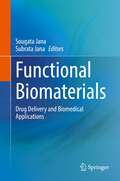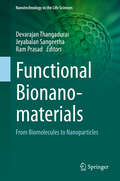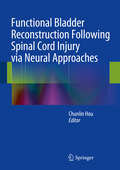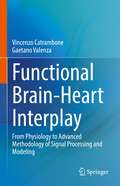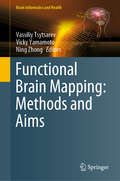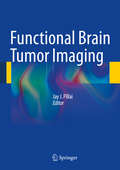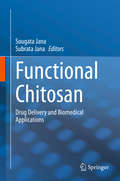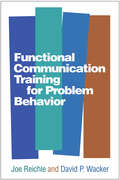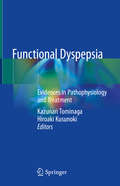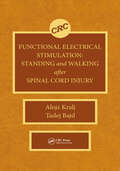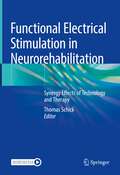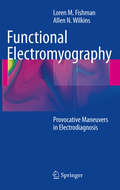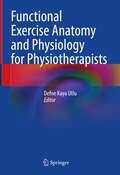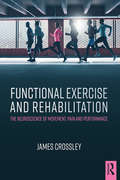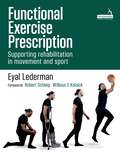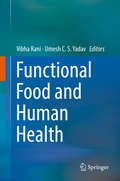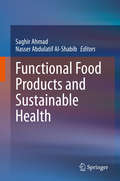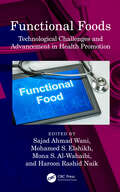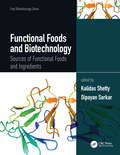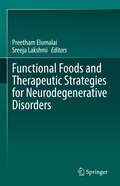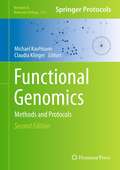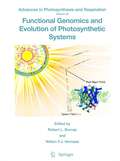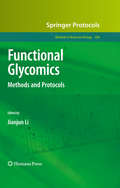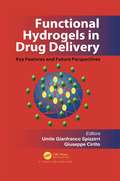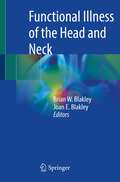- Table View
- List View
Functional Biomaterials: Drug Delivery and Biomedical Applications
by Sougata Jana Subrata JanaThis book explores in depth a wide range of functional biomaterials-based systems for drug, gene delivery, and biomedical aspects. The chapters cover newer technologies such as polymeric micelle, pH-responsive biomaterials, stimuli-responsive hydrogels, silk fibroin, inorganic biomaterials, synthetic biomaterials, 3D printed biomaterials, metallic biomaterials, ceramic and hybrid biomaterials. It also describes the theranostic approaches for cancer therapy, the biomaterials-based nanofibers scaffolds in tissue engineering, as well as the strategies applications of metallic biomaterials for the medical and dental prosthetic field. This newer and updated approach will be attractive for biomedical engineering students working on materials science in the development of novel drug delivery strategies. The book will be an important reference for researchers and professionals working on biomaterial research in the pharmaceutical and medical fields.
Functional Bionanomaterials: From Biomolecules to Nanoparticles (Nanotechnology in the Life Sciences)
by Devarajan Thangadurai Jeyabalan Sangeetha Ram PrasadThis book focuses on the application of nanotechnology in medicine and drug delivery, including diagnosis and therapy. Nanomedicine can contribute to the development of a personalized medicine both for diagnosis and therapy. By interacting with biological molecules at nanoscale level, nanotechnology opens up an immense field of research and applications. Interactions between artificial molecular assemblies or nanodevices and biomolecules can be understood both in the extracellular medium and inside human cells. Operating at nanoscale allows exploitation of physical properties different from those observed at microscale, such as the volume to surface area ratio.A number of clinical applications of nanobiotechnology, such as disease diagnosis, target-specific drug delivery, and molecular imaging are being investigated. Some promising new products are also undergoing clinical trials. Such advanced applications of this approach to biological systems will undoubtedly transform the foundations of diagnosis, treatment, and prevention of disease in the future.Nanomedicine sales reached $16 billion in 2015, with a minimum of $3.8 billion in nanotechnology R&D being invested each year. Global funding for emerging nanotechnology increased by 45% per year in recent years, with product sales exceeding $1 trillion in 2013. As the nanomedicine industry continues to grow, it is expected to have a significant impact on the global economy.This book provides clear, colorful and simple illustrations, tables, and case studies to clearly convey the content to a general audience and reader. This book also discusses the development of nanobiomaterials from biogenic (biological sources) systems for healthcare and disease therapies. This book, therefore, is useful for researchers and academicians in the fields of nanotechnology, medicine, nano-biotechnology and pharmacology.
Functional Bladder Reconstruction Following Spinal Cord Injury via Neural Approaches
by Chunlin HouOne of the most common problems for spinal cord injury patients is urinary system dysfunction. The book Functional Bladder Reconstruction Following Spinal Cord Injury via Neural Approaches introduces how to solve this problem using multi-disciplinary approaches. From animal model studies to surgical techniques as well as successful case reports, six kinds of surgery are presented in separate chapters. This up-to-date monograph will be a valuable resource for surgeons, urologists and neurologists caring for spinal cord injury patients. The contributors are a group of surgeons working in the fields of orthopaedics and microsurgery. Editor Chunlin Hou is Professor in Changzheng Hospital, the Second Military Medical University, Shanghai, China.
Functional Brain-Heart Interplay: From Physiology to Advanced Methodology of Signal Processing and Modeling
by Vincenzo Catrambone Gaetano ValenzaThis monograph offers a cross-system exchange and cross-modality investigation into brain-heart interplay. Brain-Heart Interplay (BHI) is a highly interdisciplinary scientific topic, which spreads from the physiology of the Central/Autonomous Nervous Systems, especially Central Autonomic Network, to advanced signal processing and modeling for its activity quantification. Motivated by clinical evidence and supported by recent findings in neurophysiology, this monograph first explores the definition of basic Brain-Heart Interplay quantifiers, and then moves onto advanced methods for the assessment of health and disease states. Non-invasive use of brain monitoring techniques, including electroencephalogram and function Magnetic Resonance Imaging, will be described together with heartbeat dynamics monitoring through pulseoximeter and ECG signals. The audience of this book comprises especially of biomedical engineers and medical doctors with expertise in statistics and/or signal processing. Researchers in the fields of cardiology, neurology, psychiatry, and neuroscience in general may be interested as well.
Functional Brain Mapping: Methods and Aims (Brain Informatics and Health)
by Vassiliy Tsytsarev Vicky Yamamoto Ning ZhongThis book provides an essential overview of the broad range of functional brain imaging techniques, as well as neuroscientific methods suitable for various scientific tasks in fundamental and clinical neuroscience. It also shares information on novel methods in computational neuroscience, mathematical algorithms, image processing, and applications to neuroscience.The mammalian brain is a huge and complex network that consists of billions of neural and glial cells. Decoding how information is represented and processed by this neural network requires the ability to monitor the dynamics of large numbers of neurons at high temporal and spatial resolution over a large part of the brain. Functional brain optical imaging has seen more than thirty years of intensive development. Current light-using methods provide good sensitivity to functional changes through intrinsic contrast and are rapidly exploiting the growing availability of exogenous fluorescence probes. In addition, various types of functional brain optical imaging are now being used to reveal the brain’s microanatomy and physiology.
Functional Brain Tumor Imaging
by Jay J. PillaiThis book presents a comprehensive overview of current state-of-the-art clinical physiological imaging of brain tumors. It focuses on the clinical applications of various modalities as they relate to brain tumor imaging, including techniques such as blood oxygen level dependent functional magnetic resonance imaging, diffusion tensor imaging, magnetic source imaging/magnetoencephalography, magnetic resonance perfusion imaging, magnetic resonance spectroscopic imaging, amide proton transfer imaging, high angular resolution diffusion imaging, and molecular imaging. Featuring contributions from renowned experts in functional imaging, this book examines the diagnosis and characterization of brain tumors, details the application of functional imaging to treatment planning and monitoring of therapeutic intervention, and explores future directions in physiologic brain tumor imaging. Intended for neuro-oncologists, neurosurgeons, neuroradiologists, residents, and medical students, Functional Imaging of Brain Tumors is a unique resource that serves to advance patient care and research in this rapidly developing field.
Functional Chitosan: Drug Delivery and Biomedical Applications
by Sougata Jana Subrata JanaThanks to their unique properties, chitosan and chitosan-based materials have numerous applications in the field of biomedicine, especially in drug delivery. This book examines biomedical applications of functional chitosan, exploring the various functions and applications in the development of chitosan-based biomaterials. It also describes the chemical structure of chitosan and discusses the relationship between their structure and functions, providing a theoretical basis for the design of biomaterials. Lastly, it reviews chemically modified and composite materials of chitin and chitosan derivatives for biomedical applications, such as tissue engineering, nanomedicine, drug delivery, and gene delivery.
Functional Communication Training for Problem Behavior
by David P. Wacker Joe ReichleChildren and adolescents with moderate and severe disabilities often have communication challenges that lead them to use problem behavior to convey their desires. This is the most comprehensive contemporary volume on functional communication training (FCT)--the individualized instructional approach that teaches a child socially acceptable communicative alternatives to aggression, tantrums, self-injury, and other unconventional behaviors. The expert authors provide accessible, empirically based guidelines for implementing FCT, and tips for overcoming obstacles. Grounded in the principles of applied behavior analysis, the book includes detailed strategies for developing a support plan, together with illustrative case examples.
Functional Dyspepsia: Evidences in Pathophysiology and Treatment
by Kazunari Tominaga Hiroaki KusunokiThe research and outcomes presented in this book gather evidence concerning both the pathogenesis and treatment of functional dyspepsia. It provides the latest information on this common non-organic disease, indicating its characteristic pathogenesis based on the brain-gut interaction and micro-environment and evidence gleaned from clinical treatment. Since the pathogenesis is associated with psychology, neurology, endocrinology and bacteriology in addition to gastroenterological physiology, it is often intractable and finding a suitable treatment rationale is challenging. Furthermore, the pathogenesis varies around the world and the efficacy of treatment using standard drugs varies among different populations worldwide; accordingly, this book highlights evidence gained in clinical trials in Japan. Functional Dyspepsia is a milestone produced by respected experts. Addressing unique topics and new findings of treatment including challenging and/or future rationales, it offers an invaluable resource for general clinicians, gastroenterologists, and basic researchers alike.
Functional Electrical Stimulation: Standing and Walking After Spinal Cord Injury
by Alojz Kralj Tadej BajdThis reference text covers the fundamental knowledge and principles of functional electrical stimulation (FES) as applied to the spinal cord injured (SCI) patient. The principles of FES application and basic biomechanical issues related to FES in SCI are stressed. The fundamentals regarding patient selection criteria, indication, contraindications, and descriptions of procedures are clearly presented. Also included are the fundamentals and rationale of gait restoration with patient selection, control strategies, and the synthesis of gait sequences with trends in the field. Each chapter contains numerous references to the FES literature for the reader to easily evaluate and extend his knowledge in the area of interest. Biomedical and rehabilitation engineering professionals and researchers for medical doctors, physical therapists, and orthotists will find this publication invaluable.
Functional Electrical Stimulation in Neurorehabilitation: Synergy Effects of Technology and Therapy
by Thomas SchickThis book explains to physical therapists, occupational therapists, speech therapists, interested physicians and clinicians the theoretical and practical applications of single- to multi-channel functional electrical stimulation for a wide range of neurological symptoms. The targeted electrical stimulation of several muscle groups, timed to each other, can initiate and support a complete movement sequence and thus improve motor learning. Renowned experts from research and practice have compiled numerous application examples based on the available evidence in this comprehensive form for the first time. In addition, the reader will find exciting and informative contributions to the current study situation and effectiveness analyses. The text is enriched by videos on EMG-triggered functional multichannel electrical stimulation, stimulation of muscle groups in lower motor neuron lesions, and FES therapy approaches for dysarthria and swallowing disorders. From the contents: - FES in lesions of the upper motoneuron, lesion of the lower motoneuron and mixed forms - Combination of FES with mirror therapy and botulinum toxin - Motor learning, neuroplasticity, ICF-based goal setting and the use in home-based therapy - Basic principles, current parameters and their implications - FES in rehabilitation of facial paralysis, unilateral vocal fold paralysis, dysarthria and dysphagia, and neuro-urological deficits
Functional Electromyography
by Allen N Wilkins Loren M. FishmanFunctional Electromyography: Provocative Maneuvers in Electrodiagnosis integrates electrophysiology further into the physical examination than ever before. It introduces the use of electrodiagnostic studies to quantify the neurological changes brought about by three provocative maneuvers commonly used in contemporary medicine. This widens the scope of electromyography while sharpening physicians' diagnostic acuity. The book presents nerve conduction velocity (NCV) and H-reflex techniques to identify common conditions that are difficult to diagnose by any other means, often using the needle exam (EMG), MRI or musculoskeletal ultrasound to verify their clinical utility. Functional electromyography successfully diagnoses some cases of thoracic outlet syndrome, nearly all cases of piriformis syndrome, and offers a method for determining whether spinal stenosis or radiculopathy is the main pain generator when both are present in a single patient, even at the same level. This is particularly valuable because the standard conservative and surgical treatments for these two conditions are opposite, in spite of the identical symptom-set they produce. The book carefully describes each technique and persuasively documents their validity in statistical series and individual case presentations. It further guides the attentive electromyographer to adapt these methods to cases beyond those presented in its pages, suggesting a safe and scientific approach to other functional maneuvers of value to the electromyographer, and methods for validating one-time measures that may aid the electromyographer in clinical situations that are neither common nor easily analyzed. Hand drawn illustrations are included alongside text developed by experts in the field. An invaluable resource for physiatrists, neurologists, orthopedic surgeons, specialists in pain management and other providers, Functional Electromyography: Provocative Maneuvers in Electrodiagnosis represents a major contribution to the field of electrodiagnosis.
Functional Exercise Anatomy and Physiology for Physiotherapists
by Cetin Sayaca Özden Özkal Abdulhamit Tayfur Filiz Erdem Eyüboğlu Mahmut CalikThis book aims to create a bedside resource for physiotherapists and exercise specialists dealing with a defined movement problem and plan and apply functional therapeutic exercises that can be diversified for the patient.For physiotherapists, exercise is undoubtedly the greatest weapon in treating diseases and improving health. Functional exercise approaches aim to improve physical performance and activities of daily life by adapting exercise prescriptions to the movements that the individual makes frequently in daily life or in sports. The daily activities vary from person to person due to our different habits and lifestyles. Therefore, functional exercise training should be designed differently for everyone. When designing a functional exercise prescription, physiotherapists should consider previous injuries or surgeries that may limit physical activity, as well as general health, muscular strength, endurance and strength, aerobic capacity, and activities that the patient should do in daily life. The functional exercise prescription should be customized considering both the fragility of the patient due to injury or surgery, and the strengths of the patient such as sports/exercise history and healthy eating habits.The book consists of four different parts: the concepts of exercise and physical activity, exercise types, and prescriptions are presented in the first part. The second part is dedicated to musculoskeletal anatomy specific to functional exercise, while the third part explores functional exercise-specific systems physiology and illustrates the compliance of each system with exercise, basic exercise physiology information, and the evaluation and treatment of individuals who are healthy and have diseases that affect each system. Finally, the book has the part of a special topic dealing with nutrition/nutritional supplements affecting recovery in the rehabilitation process after injury or surgery and supporting physical performance during exercise/sports. This book will be of interest to physiotherapists as well as health and sports professionals.
Functional Exercise and Rehabilitation: The Neuroscience of Movement, Pain and Performance
by James CrossleyFunctional training develops the attributes and abilities required to perform tasks, skills and activities useful and relevant to daily life. Functional Exercise and Rehabilitation serves as an accessible and visual guide providing the essentials of therapeutic exercise and rehabilitation, including mobilization, stabilization and myofascial release. This book begins by explaining functional training and the foundation of the STRIVE approach. Chapter 2 introduces functional anatomy and Chapter 3 explains the fundamentals of neuroscience. The final chapters discuss the STRIVE principles and apply them to exercise, program design and injury recovery. Each chapter includes key point boxes, illustrations and photos of exercises discussed. Written by an exercise specialist and osteopath, this practical guide is presented in an easy-to-read style. Functional Exercise and Rehabilitation is essential reading for all health professionals, sports therapists and trainers involved in exercise prescription.
Functional Exercise Prescription: Supporting rehabilitation in movement and sport
by Eyal LedermanIn Functional Exercise Prescription, Eyal Lederman presents a revolutionary new approach for exercise prescription that uses the individual's own movement repertoire. The book demonstrates how daily activities (the life gym) can be amplified to provide the necessary movement challenges to support movement rehabilitation in many musculoskeletal and pain conditions. Hence, all activities can become remedial without the need to prescribe unfamiliar exercise; in other words, 'how to exercise without exercise' or 'how to rehabilitate without exercise'.People recover from most musculoskeletal and pain conditions through three key processes: repair, adaptation, and alleviation of symptoms. The author explains how to identify the individual's recovery process and how to select the appropriate daily or sporting activities, and, how they can be modified to support recovery.Functional Exercise Prescription is a dramatic departure from the traditional strength and conditioning models that have been used for rehabilitation. The book explores the limitation of these models and explains how they can be replaced by functional daily activities ('functioncise'). It provides the practitioner with practical tools to construct a tailor-made plan for each individual to help expedite and optimize their recovery. Most rehabilitation can be constructed from a small familiar set of daily or sports activities.All human physical activity is exercise. Life is your gym.
Functional Food and Human Health
by Vibha Rani Umesh C. YadavGlobal health and the increasing incidence of various diseases are a cause for concern, and doctors and scientists reason that the diet, food habits and lifestyle are contributing factors. Processed food has reduced the nutritional value of our diet, and although supplementing foods with various additives is considered an alternative, the long-term impact of this is not known. Many laboratories around the world are working to identify various nutritional components in our daily food and their effect on human health. These have been classified as Nutraceuticals or functional food, and they may have preventive and therapeutic effects in a number of pathologies associated with modern dietary habits and lifestyles. This book addresses various aspects of this issue, revitalizing the discussion and consolidating the latest research on nutritional and functional food and their effects in in-vitro, in-vivo and human clinical studies.
Functional Food Products and Sustainable Health
by Saghir Ahmad Nasser Abdulatif Al-ShabibThere is a growing global awareness of the link between good diet and health. This fascinating book reviews various functional foods or nutraceuticals and the bio-active compounds they contain in order to identify the role of bioactive compounds such as nisin, micronutrients, and hydrocolloids in the diet in overall human health. It also provides up-to-date information on functional elements like antioxidants, dietary fibres, pre & probiotics, vitamins and mineral-enriched foods in the human diet. Consisting of fifteen chapters, the book offers a systematic review of the key factors in the preparation of functional foods from selected sources, and also describes the processing, preservation and packaging of a range of functional food products. This book is a valuable resource for students and researchers working in the field of food science, food technology, and nutrition, as well as for industry experts.
Functional Foods: Technological Challenges and Advancement in Health Promotion
by Sajad Ahmad Wani, Mohamed S. Elshikh, Mona S. Al-Wahaibi, and Haroon Rashid NaikIt is reported Functional foods are highly nutritious and associated with a number of powerful health benefits. They may protect against disease, prevent nutrient deficiencies, and promote proper growth and development. Functional Foods: Technological Challenges and Advancement in Health Promotion presents information related to bioactive compounds present in the functional foods, derived from fruits and vegetables, cereals and pulses, dairy and meat, herbs and spices and other foods. It describes novel techniques and methodologies used in the extraction, isolation, encapsulation, identification and characterization of bioactive compounds. Key Features: Covers the most recent research related to the bioactive compounds present in the functional foods Presents the latest information on extraction, isolation, encapsulation, identification and characterization Discusses formulation challenges with an emphasis on stability and safety evaluations of functional foods Finally, it includes substantial and scientific research and innovation for new product development with health benefits. This book will serve as a valuable resource for researchers, academicians, and students interested in many aspects of functional foods.
Functional Foods and Biotechnology: Sources of Functional Foods and Ingredients (Food Biotechnology Series)
by Kalidas Shetty Dipayan SarkThe first of two related books that kick off the Food Biotechnology series, Functional Foods and Biotechnology: Sources of Functional Foods and Ingredients, focuses on the recent advances in the understanding of the role of cellular, metabolic, and biochemical concepts and processing that are important and relevant to improve functional foods and food ingredients targeting human health benefits. This volume explores sources of ecologically-based diversity of functional foods and food ingredients that are available to enhance diverse nutritional values and functional benefits of foods for better human health outcomes, especially focusing on emerging diet and lifestyle-linked non-communicable chronic disease (NCDs) challenges. The contributors with expertise in the field of Food Biotechnology and Functional Food Ingredients have integrated the recent advances in some common as well as novel sources of functional foods and ingredients from diverse ecological and cultural origins. Further, these chapters also highlight human health relevant bioactive profiles and associated functionalities of these health-promoting compounds, including preventative functional roles for common NCD-linked health benefits. FEATURES: Provides ecological and metabolic rational to integrate novel functional food and functional ingredient sources in wider health-focused food system innovations. Examines the value-added role of select functional foods and food ingredients to improve NCD-linked health benefits such as type-2 diabetes, cardiovascular disease, and human gut improvement Includes insights on system-based solutions to advance climate resilient and health focused food diversity based on diverse biotechnological approaches to design and integrate functional food and food ingredient sources Overall, the rationale of this book series is focused on Metabolic-Driven Rationale to Advance Biotechnological Approaches for Functional Foods, the synopsis of which is presented as the Introduction chapter, which is followed by a chapter on current understanding about regulatory guidelines for health claims of functional foods and food ingredients. Special topics on nonnutritive sweeteners, caroteneprotein from seafood waste, and Xylooligosaccharides as functional food ingredients for health-focused dietary applications are integrated in this book. Additionally, ecologically and metabolically-driven functional roles of common food sources such as corn, and barley and some novel food sources, such as ancient emmer wheat, black soybean, fava bean, herbs from Lamiaceae and functional protein ingredients and minerals from Lemnaceae are also highlighted in this volume. The overall goal is to provide insights on role of these functional food and ingredient sources for their integration in wider health-focused food systems, which will help food scientists, food industry personnel, nutritionists, crop science researchers, public health professionals, and policy makers to make appropriate decisions and to formulate strategies for improving health and well-being. A related book focuses on biological and metabolically driven mobilization of functional bioactives and ingredients and their analysis that is relevant in health and wellness.
Functional Foods and Therapeutic Strategies for Neurodegenerative Disorders
by Preetham Elumalai Sreeja LakshmiThis book provides a comprehensive summary of the latest knowledge regarding functional foods and new therapeutic strategies for neurodegenerative disorders through explaining specific mechanisms for natural remedies and functional foods as well as alternative treatment and supplementary approaches for neurodegenerative diseases. Many relevant topics are covered, including role of prebiotics, recent applications for dietary polyphenols, marine bioactive compounds for neuro disorders, and age-related disorders. The roles of various remedies and functional foods are explained for various types of diseases, and the book also integrates the role of functional foods and remedies to work with the current therapeutics that are taking place. In parallel, the information presented through this book will also stimulate current status of leading contemporary methods for prohylactic and diagnostic practices, comprising nanoparticles, biomarkers, in silico techniques, and CRISPR-mediated genome editing–based therapy. The book will be essential reading for students and researchers with an interest in natural medicine, drug development, and food therapeutic strategies. In presenting new results and approaches and identifying areas for future research, it will also be of benefit for specialists in the field.
Functional Genomics
by Michael Kaufmann Claudia KlingerOver the last decade Life Science has undergone an accelerated evolution, culminating in the -omics era characterized by the development of a multitude of high throughput methods that are becoming more routinely applied in biochemistry labs. In Functional Genomics: Methods and Protocols, Second Edition expert researchers in the field detail many of the methods which are now commonly used for studies in the life sciences focusing on the dynamic aspects of the transcriptome, proteome and metabolome, respectively.Written in the highly successful Methods in Molecular BiologyTM series format, chapters include introductions to their respective topics, lists of the necessary materials and reagents, step-by-step, readily reproducible laboratory protocols, and key tips on troubleshooting and avoiding known pitfalls. Authoritative and practical, Functional Genomics: Methods and Protocols, Second Edition seeks to aid scientists in establishing or extending technologies and techniques in their laboratories.
Functional Genomics and Evolution of Photosynthetic Systems
by Robert Burnap Wim VermaasNew possibilities have been brought about by the stunning number of genomic sequences becoming available for photosynthetic organisms. This new world of whole genome sequence data spans the phyla from photosynthetic microbes to algae to higher plants. These whole genome projects are intrinsically interesting, but also inform the variety of other molecular sequence databases including the recent 'meta-genomic' sequencing efforts that analyze entire communities of organisms. As impressive as they are, are obviously only the beginning of the effort to decipher the biological meaning encoded within them. This book aims to highlight progress in this direction. This book aims toward a genome-level understanding of the structure, function, and evolution of photosynthetic systems and the advantages accrued from the availability of phyletically diverse sets of gene sequences for the major components of the photosynthetic apparatus. While not meant to be fully comprehensive in terms of the topics covered, it does provide detailed views of specific cases and thereby illustrates important new directions that are being taken in this fast-moving field--a field that involves the integration of bioinformatics, molecular biology, physiology, and ecology.
Functional Glycomics
by Jianjun LiThe study of functional glycomics requires the continuous development of rapid and sensitive methods for the identification of glycan structures and integration to structure-function relationships. In Functional Glycomics: Methods and Protocols, a panel of world-renowned experts provide new developments and emerging glycomics techniques in the form of detailed protocols exploring the fundamental challenges and most cutting-edge novel applications. Written in the highly successful Methods in Molecular BiologyTM series format, chapters in this volume present brief introductions to their respective topics, lists of the necessary materials and reagents, step-by-step, readily reproducible laboratory protocols, and notes sections, highlighting key tips on troubleshooting and avoiding known pitfalls. Authoritative and easy to use, Functional Glycomics: Methods and Protocols serves as an ideal reference for scientists working in biochemistry, molecular biology, cell biology, immunology, microbiology, and virology and a guide to appropriate techniques and the design of achievable research plans in this vital field.
Functional Hydrogels in Drug Delivery: Key Features and Future Perspectives
by Umile Gianfranco Spizzirri Giuseppe CirilloThe book deals with the synthesis and characterization of hydrogels specifically used as drug delivery systems. Each chapter includes the most recent updates about the different starting materials employed and the improvement of their physicochemical and biological properties to synthetize high performing carriers for specific uses.
Functional Illness of the Head and Neck
by Brian W. Blakley Joan E. BlakleyThis book uniquely discusses an approach to illnesses for which the causes are unknown. It fills the gaps in the literature by relaying research on functional illness, identifying and assessing various options, and indicating some decision-making suggestions that should help clinicians and patients think about therapy. Special considerations for functional illness include “probability” explanations based on the experience of others, serious consideration of the severity of symptoms before treatments are applied, and balancing the risks, costs, and consequences of treatment; including the patient’s thoughts and attitudes is critical for success in treating functional illness. Unique and comprehensive, Functional Illness is an invaluable reference for medical physicians of all specialties who wish to understand better and identify functional illness symptoms.
